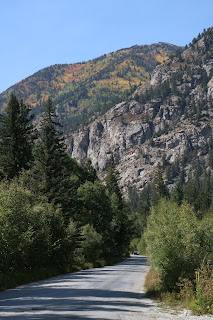48 degrees this morning. We are at about 9000' elevation!
Leisurely morning with ham and egg breakfast tacos and oranges before we head up the last crazy few miles to Victor.
There are signs of massive strip mining there, also known locally as surface mining, leaving some pretty barren looking areas. We did see a few signs that indicated that there was restoration going on, but didn't notice the actual restoration.
Victor was home to the world's greatest gold camp, which produced more than $125 million of gold. There is still some minor mining going on, but not the huge production of the early 1900's.On to Florissant Fossil Bed National Monument. Have seen this on maps for years so decided to finally check it out. Unfortunately the visitor's center is closed, though they did have a few manned tables outside with information and a small display of fossils. The main draw is a trail that goes to several huge petrified wood stumps from ancient redwood trees. 34 million years ago, this was a warm temperature area with seas and redwoods which were buried by volcanic eruptions.
Now it is a great area for fossils. "The Big Stump", is estimated to have come from a tree 230' tall and between 500 and 1000 years old! You can still see the grain in the petrified wood and count the rings on these once huge redwoods.They were doing some geological mapping in the area, looking for other buried stumps.
I thought this sign was cute.
From here, we headed west and into the mountains for a look at St. Elmo, a mining ghost town that is well maintained. Beautiful road to St. Elmo with a nice stream and the beginnings of Fall color high on the mountains.

Heading back out 162, we stopped at Cascade Campground, a US Forest Service spot with nice but primitive sites for $11 a night. It had 20 sites, half of which were empty. Greg cooked hamburgers on the grill and we walked a short distance to check out Cascade Creek. Nice cool evening with a terrific pine scent in the air.























No comments:
Post a Comment